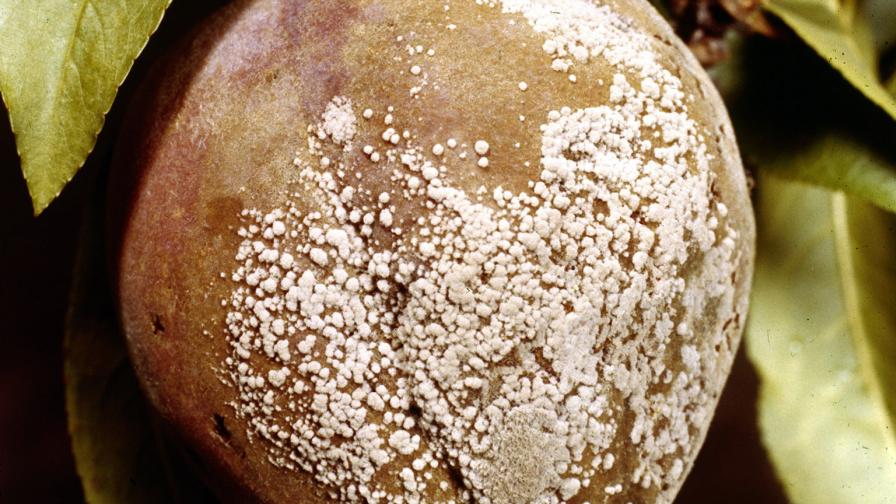Take Control Now of Brown Rot In Stone Fruit Crops

Brown rot symptoms plague this peach. Finding the right mix in your fungicide program can help find the path to getting control of brown rot.
Photo by Clemson University – USDA Cooperative Extension Slide Series , Bugwood.org
Peach growers in the Southeast take notice: When treating brown rot, just as much attention should be given to resistance management as disease management. Guido Schnabel, a Professor of Plant Pathology at Clemson University, issued that directive while speaking at the Southeast Regional Fruit and Vegetable Conference. Already a big issue, resistance will intensify, he says, when tighter chemical restrictions are eventually implemented.
“And once brown rot develops resistance to the three chemical classes that we basically have to control it, we’re going to be in trouble,” Schnabel says. “We’re going to be left with spraying, maybe, captan during preharvest season, and we don’t want this to happen. I’m putting all my energy behind this to make sure that this is not happening.”
FUNGICIDE UPDATE
Despite integrated approaches to brown rot management, growers are still reliant on fungicides to control preharvest and postharvest brown rot. Multisite fungicides, such as captan and chlorothalonil, have a higher toxicity profile but are less prone to resistance. Single-site fungicides are the converse.
Future use of both multisite fungicides is in question because of the EPA’s Federal Insecticide, Fungicide, and Rodenticide Act (FIFRA). Strawberry growers, Schnabel believes, are going to lose thiram and ziram. Peach growers, meanwhile, will only have to deal with restrictions to captan (reduced maximum rate from 4 to 3 pounds of active ingredient per application) and chlorothalonil (restricted to 6.2 pounds of active ingredient per acre per year, meaning two applications at the full rate).
“I think we’re going to be OK,” Schnabel says.
Restrictions on single-site fungicides will be minimal, he says, but at the same time no new modes of action for preharvest brown rot control have been developed in two decades.
Fludioxonil may be the exception, Schnabel adds. The active ingredient is a component, along with propiconazole, of Chairman (Syngenta) and is highly effective against postharvest Monilinia. “There is talk about maybe registering that for preharvest season,” he says.
SPRAY STRATEGY
Peach growers should adhere to the standard brown rot spray program, Schnabel says, while considering recent research conducted by him, Clemson master’s student Will Gura, and University of Georgia Fruit Disease Specialist Phillip Brannen.
The key is to use fungicides of the same chemical class (same FRAC code) only once or twice per season. Early season involves single-site fungicides iprodione (e.g., Rovral, FMC; FRAC 2) and cyprodinil (e.g., Vangard, Syngenta; FRAC 9) for blossom blight control, followed by multisite fungicides chlorothalonil for peach scab and captan for green fruit rot control.
By preharvest, the call goes to FRAC 7 (succinate dehydrogenase inhibitor) and 11 (strobilurin) fungicides that can develop resistance but are more active. These include premixtures fluxapyroxad/pyraclostrobin (Merivon, BASF), trifloxystrobin/fluopyram (Luna Sensation, Bayer), and boscalid/pyraclostrobin (Pristine, BASF).
“The 7’s and 11’s have just excellent activity, and the residual effect throughout preharvest season, reaching into postharvest season, is incredible, especially for the newer Merivon and Luna Sensation,” Schnabel says. “It’s much better than what we had in the past.”
For that reason, Schnabel remains comfortable next spraying — at a high rate — FRAC 3 demethylation inhibitors (DMIs), such as tebuconazole (e.g., Orius, Makhteshim Agan), fenbuconazole (Indar, Corteva), and mefentrifluconazole (Cevya, BASF).
“In a spray program, the high rate of DMI fungicides will still work fine, even on existing resistant pathogen populations,” Schnabel says. “My student Will Gura established that, for the last 20 years, we have done great managing DMI resistance. So, we’re using that and then following up, maybe, with another 7 and 11 if a third application is necessary, perhaps after first pick.”
The application of a postharvest material containing fludioxonil (Scholar or Chairman, Syngenta) in the packinghouses is optional, according to Schnabel, and applied to mid- to late-season cultivars if disease pressure warrants additional rot protection.
“It is super important that we use our single-site fungicides as little as possible and strategically and, even better, in mixtures,” Schnabel says.
Some of the newer FRAC mixtures include FRAC 3 and 7 products. They include two 3/7’s: difenoconazole/pydiflumetofen (Miravis Duo, Syngenta) and difenoconazole/fluopyram (Luna Flex, Bayer). Others are a mixture of 3/11 azoxystrobin/difenoconazole (Quadris Top, Syngenta).
“These mixtures all have the FRAC 3’s in them. The DMI fungicides, which are the FRAC 3’s, are still critically important to us,” Schnabel says. “The question becomes how do we fit those new mixtures into our program?”
The 3/9 mixes can be used once as a second application after the 7/11 application, Schnabel says. More effective in the same slot, he adds, are the 3/7 mixes. Finally, the 3/11 mixes can be used in a similar fashion to the 3/7’s. “All of those are good examples of how we can manage resistance,” Schnabel says.










